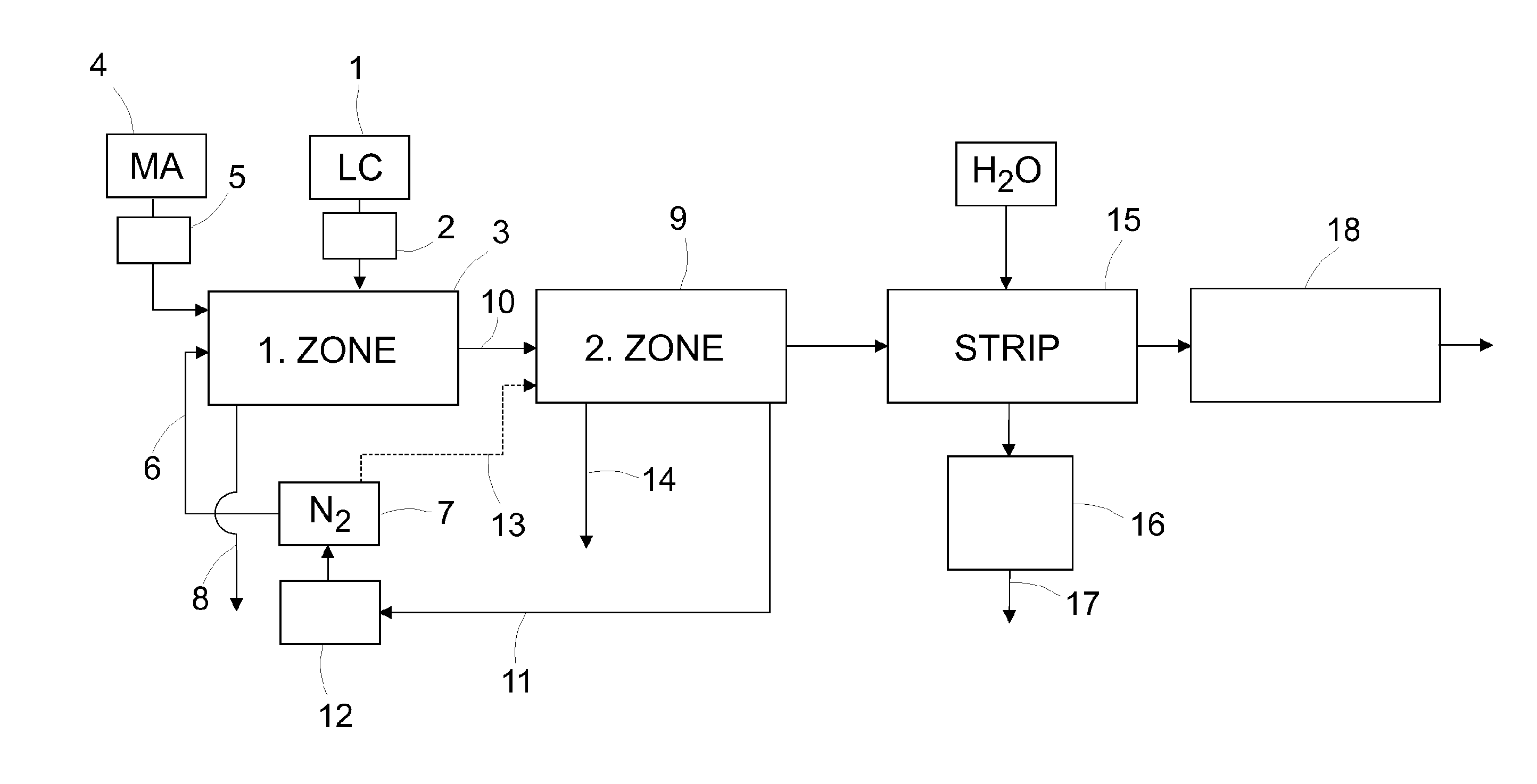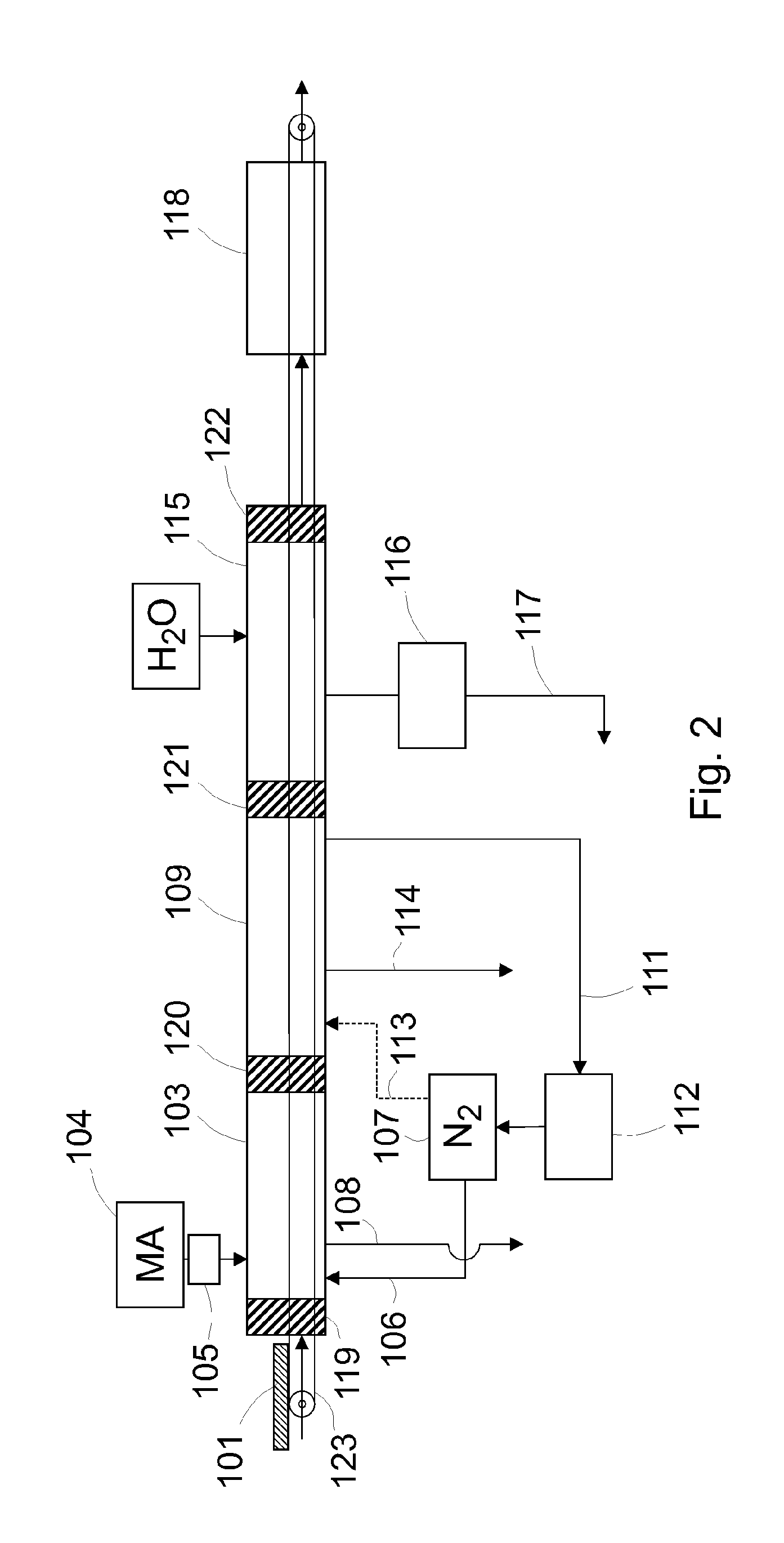Process and apparatus for modification of lignocellulosic materials and products of modified lignocellulosic materials obtained by the process
a technology of lignocellulosic materials and process equipment, which is applied in the field of process and apparatus for the preparation of modified lignocellulosic materials, can solve the problems of severe emission from the feed of the reactor, the inability of the rowel to teach the effect of avoiding contact with ambient moisture and oxygen, and the process is too complex and expensive for a commercial process at large scal
- Summary
- Abstract
- Description
- Claims
- Application Information
AI Technical Summary
Benefits of technology
Problems solved by technology
Method used
Image
Examples
example 1
[0122]Laboratory experiments were carried out to simulate the activation in the first activator zone.
[0123]5 g acetic anhydride was added to a 500 ml rotary flask with heating mantle. Then 10 g cold (ambient temperature) lignocellulosic fibre (average: length about 4 mm and a thickness (diameter) of 0.02-0.04 mm) was added to the flask and the sample was rapidly heated to about 120° C. and the temperature was maintained in 20-25 minutes under moderate rotation.
[0124]The sample was stripped conventionally with isopropyl alcohol (IPA) and dried in an oven over night. 5 test runs gave weight gains from 8 to 12% by weight with an average of 10% by weight. Thus, about 50% of the modification agent (acetic anhydride) was reacted with the lignocellulosic hydroxyl groups, whereas the acetic acid formed as by product and unreacted acetic anhydride were removed by the IPA-stripping.
[0125]The experiment was repeated with chips for MDF (average: 1-4 cm×1-2 cm×0.2-1 cm) with weight gains from 8 ...
example 2
[0127]This example illustrates by laboratory experiments the inventive 2 step process combining the activation in the first activator zone with a following reaction in an oven at 135-145° C. as the second reactor zone.
[0128]In the same way as in example 1, 5 g acetic anhydride was added to a 500 ml rotary flask with heating mantle. Then 10 g cold (ambient temperature) lignocellulosic fibre was added and rapidly heated to about 120° C. and the temperature was maintained in 20-25 minutes under moderate rotation.
[0129]The sample was transferred to a pre-heated and vented oven and was heated at 135-145° C. in 20-25 minutes.
[0130]The reacted sample was stripped conventionally with isopropyl alcohol (IPA) and dried in an oven over night. 5 test runs gave weight gains from 18 to 22% by weight with an average of 20% by weight. Thus, this 2 step modification appears to be very effective as almost all of the modification agent (acetic anhydride) had reacted with the lignocellulosic hydroxyl g...
example 3
[0133]This example illustrates modification with a dicarboxylic anhydride. Maleic anhydride has to be heated to above its melting point at 52° C. before the activation.
[0134]3 g maleic anhydride was added to a 500 ml rotary flask with heating mantle and was heated to 80° C. under rotation. Then 10 g cold (ambient temperature) lignocellulosic fibre was added to the flask and the sample was heated at about 140° C. in 20-25 minutes under continued rotation.
[0135]The sample was transferred to a pre-heated and vented oven and was heated at 145-165° C. in 20-25 minutes.
[0136]The reacted sample was stripped conventionally with isopropyl alcohol (IPA) and dried in an oven over night. 5 test runs gave weight gains from 18 to 22% by weight with an average of 20% by weight. This example shows that an effective modification by the present 2 step process also is obtainable when the modification agent is a dicarboxylic anhydride as almost all of the modification agent (maleic anhydride) had react...
PUM
| Property | Measurement | Unit |
|---|---|---|
| temperature | aaaaa | aaaaa |
| pressure | aaaaa | aaaaa |
| temperature | aaaaa | aaaaa |
Abstract
Description
Claims
Application Information
 Login to View More
Login to View More - R&D
- Intellectual Property
- Life Sciences
- Materials
- Tech Scout
- Unparalleled Data Quality
- Higher Quality Content
- 60% Fewer Hallucinations
Browse by: Latest US Patents, China's latest patents, Technical Efficacy Thesaurus, Application Domain, Technology Topic, Popular Technical Reports.
© 2025 PatSnap. All rights reserved.Legal|Privacy policy|Modern Slavery Act Transparency Statement|Sitemap|About US| Contact US: help@patsnap.com



